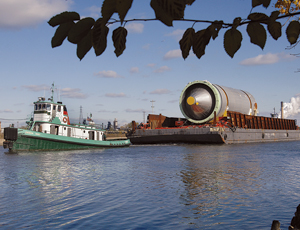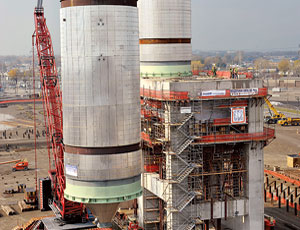Michigan’s only refinery is injecting some new economic vitality into depressed Detroit with a $1.9-billion upgrade that will allow it to process an additional 80,000 barrels per day of heavy crude from Canada’s oil-sands fields.


The 78-year-old Detroit Refinery, owned by Findlay, Ohio-based Mar-athon Petroleum Co. LLC, currently processes 102,00 barrels per day of crude oil “into products such as gasoline, kerosene, asphalt and diesel fuel,” says Marathon spokesperson Christiane Fox. The new work includes building a new coker unit, retrofitting emission-control technology and laying 29 miles of 24-in.-dia. pipeline. The coker unit will allow the refinery to convert the heavy crude into higher-quality products, she adds.
The Detroit Heavy Oil Upgrade Project (Detroit HOUP) started in June and was to be completed in late 2010, but Marathon may extend it as the price of crude oil plummets.
Marathon is a partner in Canada’s Athabasca Oil Sands Project in northeastern Alberta, which also is slowing projects, but the refinery gets its heavy crude from a variety of domestic and Canadian sources. “Canada is second only to Saudi Arabia in proven reserves, which makes it an attractive and secure supply source,” says Fox.
The main project has four segments: One is a 17-acre greenfield section that includes erecting a two-drum coker unit, a sulfur-recovery complex, new flare buildings and an instrument-plant air system along with interconnecting pipe racks. Another segment involves constructing a 33,000-bpd diesel hydrotreater to scrub impurities and expanding boiler-steam generation for utilities and process work in a five-acre brownfield area. Other segments include installing pipe racks, storage tanks, fire-suppression systems and wastewater piping, along with revamping a crude-separation unit.
Fluor Constructors International Inc., the Irving, Texas-based union arm of the global contractor, is running the project. “It is basically an EPC contract with some direct hire and some construction management,” says Jack D. Penley, Fluor’s site manager. The job will have an average of 800 craft workers on site, with a peak of 1,300.
To enhance productivity, Fluor displays a three-week construction sequence for crews on large screens using a proprietary 3D program. “I believe that will increase productivity beyond what can be imagined,” says Penley. “With a limited amount of craft we have to use technology to make us more efficient.”
The crafts are driving 7,500 90-ft-long steel H-piles, pouring 55,000 cu yd of concrete, installing 595,355 ft of pipe averaging 5.5 in. dia., and installing 180 heat exchangers and 16 compressors.
Fifty pipe-rack and process modules weighing between 220 tons to 530 tons were fabricated in Tampico, Mexico. To build the coke structure, Fluor imbedded smart chips in foundation concrete to speed pour times by monitoring curing temperatures. “We knew exactly what was happening temperature-wise and could pour subsequent lifts faster, saving 10 to 14 days per lift,” says Penley. “We went from piling to setting drums in 19 weeks,” he adds.
As a result of a 2005 Texas City, Texas, BP refinery explosion that killed 15, Fluor is using pneumatic blast-and-fire resistant shelters to house staff and craft. The shelters are made of PVC-coated polyester outer-shell layers and columns that “assist in diverting some of the pressure or shock waves from entering the structure,” says Harold A. Warner, president of Dynamic Air Shelters, Calgary. “After Texas City, we tested and validated our structures, which distort when responding to explosive force.”

Post a comment to this article
Report Abusive Comment